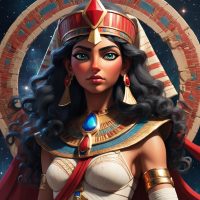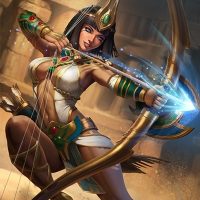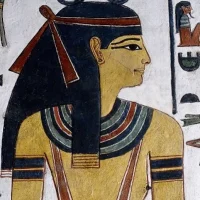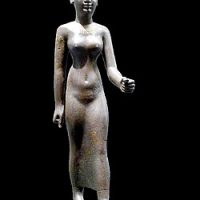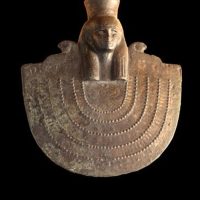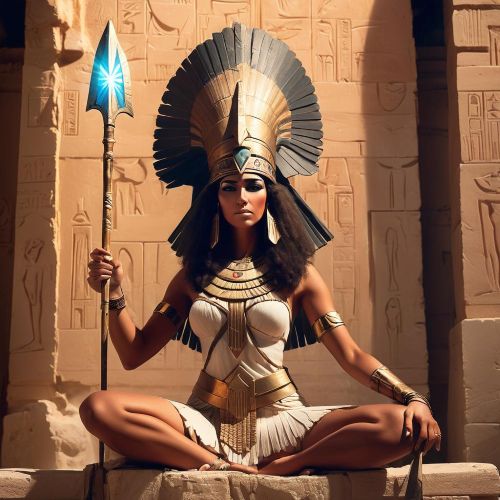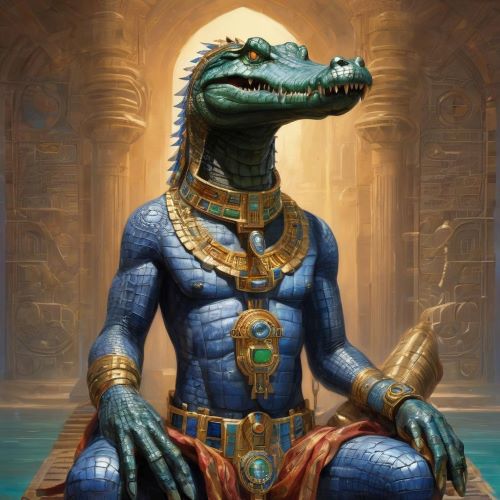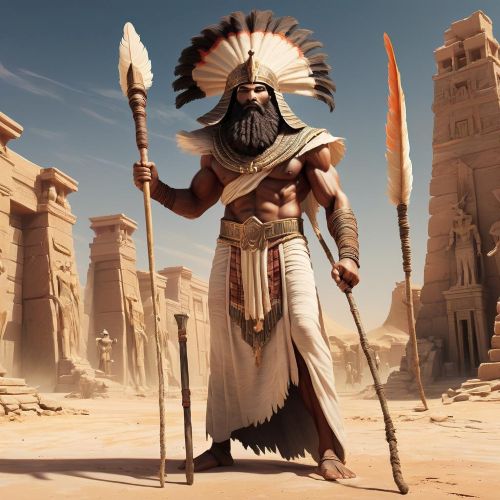Neith : The Warrior Weaver
Listen
At a glance
| Description | |
|---|---|
| Origin | Egyptian Mythology |
| Classification | Gods |
| Family Members | N/A |
| Region | Egypt |
| Associated With | Weaving, War |
Neith
Introduction
Neith, one of the oldest and most revered deities in ancient Egyptian mythology, embodies both the strength of a warrior and the nurturing creativity of a mother. She was venerated from Egypt’s Predynastic era, around 3600 BCE, through the Greco-Roman period, reflecting her enduring prominence in Egyptian religion. Worshipped primarily at Sais in the Nile Delta, Neith was considered a goddess of war, wisdom, weaving, and creation. Her myth presents her as a self-generated deity, existing before the formation of the universe, who brought forth gods, people, and all forms of life. Both feared and adored, she held influence over life and death, creation and destruction, embodying the cyclical essence of the Egyptian cosmos. The Greeks later identified her with Athena due to her intellectual and martial attributes, highlighting her universal archetype as a goddess of balance and divine power.
Physical Traits
In Egyptian iconography, Neith is portrayed as a majestic woman crowned with the Red Crown of Lower Egypt, symbolizing her sovereignty over the Delta region. She is often shown carrying a bow and arrows or a shield crossed by arrows, illustrating her martial strength and her title as the “Mistress of the Bow.” These symbols also connect her to hunting and warfare, aligning her with divine protection over soldiers and kings. Yet, her other symbols — particularly the loom and weaving shuttle — express her role as the cosmic weaver who threads life, fate, and the universe itself.
In some representations, Neith carries the ankh, the symbol of life, and the was-scepter, representing authority and divine power. In more maternal depictions, she is shown nursing young crocodiles, linking her to the Nile’s fertility and her role as the mother of Sobek, the crocodile god. Her colors and motifs often feature blue and green, reflecting water and life, as well as red tones for power and vitality. As a creator goddess, she was thought to have woven the very fabric of existence from the primordial waters of Nun — her weaving threads symbolizing the bonds that connect all beings.
Family
Neith’s lineage is among the most mysterious in Egyptian theology, largely because she is often described as self-created. Ancient texts describe her emerging from the chaos of Nun at the dawn of time, giving birth to Ra, the sun god, through her own will. In other traditions, she is the mother of Sobek, embodying the fecundity of the Nile, and sometimes linked to Set, the god of chaos, in later mythic reinterpretations. These diverse associations underline her role as a primordial force from which both order and chaos sprang.
In creation myths, Neith stands apart from typical divine hierarchies, for she exists before male and female divisions — embodying both generative and destructive powers. She was also one of the four goddesses (along with Isis, Nephthys, and Selket) who guarded the canopic jars in tombs, protecting the stomach of the deceased through the jackal-headed god Duamutef. This dual role as mother and protector made her an essential figure in both cosmology and funerary religion, linking creation with preservation.
Other names
Neith’s name appears in many variations, including Nit, Net, and Neit, reflecting linguistic shifts across dynasties and regional dialects. The hieroglyphs for her name — typically a shield crossed by two arrows — reinforce her dual nature as protector and warrior. In Greek inscriptions, her name was transliterated as Neith (Νηΐθ), and her cult became associated with Athena, blending Egyptian and Hellenic traditions of wisdom and war.
Her titles across history emphasize her cosmic breadth: “The Great Mother,” “Opener of the Ways,” “Mistress of the Bow,” and “The First One, Who Illuminated the First Face.” Each epithet reveals a different facet — from the primeval mother who gave birth to the sun, to the divine strategist who opens paths between worlds. Through these names, Neith’s presence extended far beyond Egypt’s borders, influencing early Libyan and Berber spiritual traditions, possibly merging into the later Carthaginian goddess Tanit.
Powers and Abilities
Neith’s powers encompass creation, wisdom, warfare, and protection — a rare blend of generative and destructive authority. As a creator goddess, she was believed to have spoken the universe into existence. According to temple inscriptions at Esna, Neith conceived everything in her heart and brought it forth through her word, a concept similar to later theological notions of divine logos. She was thus both the source and sustainer of life, a “Virgin Mother” who needed no consort to create.
Her inscription at Sais famously proclaimed: “I am all that has been, that is, and that will be. No mortal has ever lifted my veil. The fruit I bore was the sun.” This declaration not only highlights her role as the mother of Ra but also establishes her as the hidden, eternal essence behind creation itself — the invisible force sustaining the universe.
As a goddess of war, Neith armed and protected Egypt’s soldiers. Her emblem of crossed arrows symbolized strategic intelligence as much as combat prowess. In royal mythology, pharaohs invoked her blessing before battles and dedicated their victories to her honor. Yet, her martial side was tempered by her role as a mediator. In the famous mythic dispute between Horus and Set for the throne of Egypt, the gods turned to Neith for arbitration. Her judgment — that Horus should rule — was final, and her warning that defying her decision would cause the sky to collapse revealed her power over cosmic stability.
In funerary religion, Neith’s protective energy extended to the dead. She guarded the eastern side of the coffin and safeguarded the organs of the deceased, ensuring safe passage into the afterlife. Her association with weaving made her the divine seamstress who wrapped mummies, symbolically reweaving their souls for rebirth.
Modern Day Influence
In the modern world, Neith’s mythology continues to inspire scholars, artists, and spiritual seekers alike. Egyptologists regard her as one of the earliest reflections of a self-generating deity — a precursor to later theological and philosophical concepts of creation ex nihilo (creation from nothing). Her enduring duality as both warrior and mother resonates with contemporary interpretations of feminine divinity, often invoked in feminist theology as an emblem of power, creativity, and independence.
In popular culture, Neith has found new life in modern media. She appears as a playable character in the video games SMITE and SMITE 2, depicted as a powerful archer who weaves magical webs of energy — a nod to her mythic domains of war and weaving. In Marvel Comics, Neith exists as a cosmic figure tied to ancient Egyptian lore, and her archetype influences characters in fantasy literature and speculative fiction that celebrate the balance between creation and destruction.
Artistic depictions of Neith continue to appear in museum exhibits, jewelry, and tattoos, often portraying her as a symbol of empowerment and resilience. Modern neopagan and Kemetic spiritual movements revere her as a goddess of self-sufficiency and wisdom, drawing from her ancient epithet as “She Who Was Before the Gods.”
Neith’s myth endures because it transcends categories — she is both weaver and warrior, mother and maiden, creator and destroyer. Her story reminds us that creation and conflict are interwoven threads in the cosmic fabric she eternally spins, making her one of the most profound and timeless figures of Egyptian mythology.
Related Images
Source
Wikipedia contributors. (2002, September 30). Neith. Wikipedia. https://en.wikipedia.org/wiki/Neith
Britannica, T. Editors of Encyclopaedia (2024). Neith – Students. Britannica Kids. https://kids.britannica.com/students/article/Neith/312666
Ancient Egypt Online. (2023, September 30). Neith. https://ancientegyptonline.co.uk/neith/
Literary Tours Egypt. (2024, February 28). Neith: The goddess who created the world. https://literarytoursegypt.com/neith-the-goddess-who-created-the-world/
The Curious Egyptologist. (2021, May 13). Neith – ‘The Great Mother’ and ‘Ruler of Arrows’. https://thecuriousegyptologist.com/2021/05/14/neith-the-great-mother-and-ruler-of-arrows/
Britannica, T. Editors of Encyclopaedia (1998, July 19). Neith | Warrior Goddess, Ancient Egypt, Sky Goddess. Britannica. https://www.britannica.com/topic/Neith
Wikipedia contributors. (2006, October 28). Egyptian mythology. Wikipedia. https://en.wikipedia.org/wiki/Egyptian_mythology
World History Encyclopedia. (2016, April 13). Egyptian Gods – The Complete List. https://www.worldhistory.org/article/885/egyptian-gods—the-complete-list/
Pinch, G. (2002). Egyptian Myth: A Very Short Introduction. Oxford University Press.
Hart, G. (2005). The Routledge Dictionary of Egyptian Gods and Goddesses. Routledge.
Wilkinson, R. H. (2003). The Complete Gods and Goddesses of Ancient Egypt. Thames & Hudson.
Lesko, B. S. (1999). The Great Goddesses of Egypt. University of Oklahoma Press.
Teeter, E. (2011). Religion and Ritual in Ancient Egypt. Cambridge University Press.
Frequently Asked Questions
What is lorem Ipsum?
I am text block. Click edit button to change this text. Lorem ipsum dolor sit amet, consectetur adipiscing elit. Ut elit tellus, luctus nec ullamcorper mattis, pulvinar dapibus leo.
What is lorem Ipsum?
I am text block. Click edit button to change this text. Lorem ipsum dolor sit amet, consectetur adipiscing elit. Ut elit tellus, luctus nec ullamcorper mattis, pulvinar dapibus leo.
What is lorem Ipsum?
I am text block. Click edit button to change this text. Lorem ipsum dolor sit amet, consectetur adipiscing elit. Ut elit tellus, luctus nec ullamcorper mattis, pulvinar dapibus leo.
What is lorem Ipsum?
I am text block. Click edit button to change this text. Lorem ipsum dolor sit amet, consectetur adipiscing elit. Ut elit tellus, luctus nec ullamcorper mattis, pulvinar dapibus leo.
What is lorem Ipsum?
I am text block. Click edit button to change this text. Lorem ipsum dolor sit amet, consectetur adipiscing elit. Ut elit tellus, luctus nec ullamcorper mattis, pulvinar dapibus leo.


